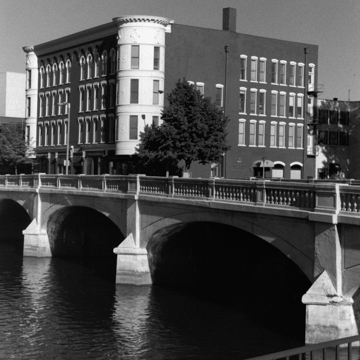Janesville gets its name from Henry Janes, a European American settler. Where the Lappin-Hayes Block now stands, Janes built a timber house in 1836. He set up a ferry service across the nearby Rock River, along with a tavern and the county’s first post office. Thomas Lappin, another early settler, opened Janesville’s first retail business in 1839. He erected this brick commercial and office block, which stood at the core of cultural and social life in Janesville. The top two stories contained a hall seating eight hundred people for performances, dances, and community events.
Lappin’s brick Italianate building has cast-iron storefronts with recessed entrances. The second through fourth stories features tall window bays set beneath a round-arched arcade. In 1899, the Chicago firm of Peabody and Beauley gave the building a new look. Although they retained the original storefronts, arcade, and window hoods, they added round corner towers clad in pressed metal and a metal cornice running along the roofline. Geometric designs, cartouches, garlands, and modillion blocks embellish these additions. They redesigned the interior as well, adding an elevator and a central lightwell. When completed, the refashioned building became what was later described as Janesville’s first modern office building.















